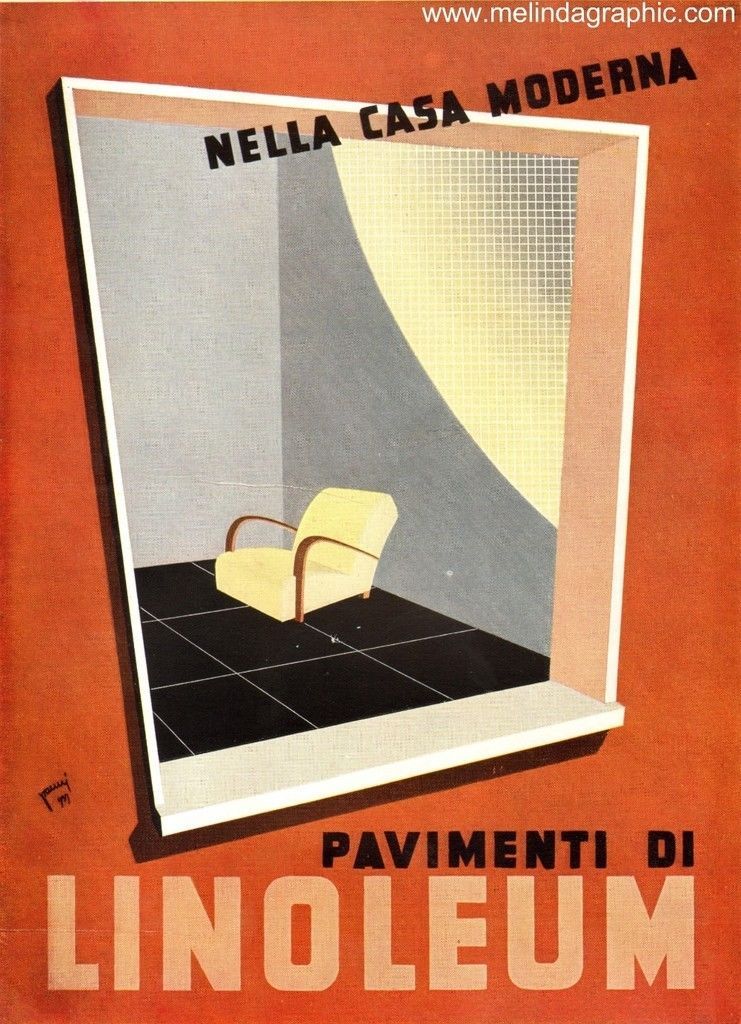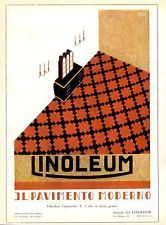Form and Function in Pirelli Resilient Flooring – from the Late 1800s to the 1980s:
By the end of the nineteenth century, the many everyday applications of rubber began to include its use for carpets and floors. Elastic rubber mats for platforms, carriages and entrances appeared in Pirelli’s first general catalogue in 1886, which included lithographic illustrations of carpets by the painter and engraver Giuseppe Barberis. However, the first catalogue for floors and tiles in our Historical Archive is dated 1912. “The rubber floor has some characteristics that make it like no other: it is extremely resistant and durable, and its smooth surface it is easy to wash and does not attract dust. It is soft and elastic and it muffles noises. The variety of colours and decorations that are available makes it ideal to accompany every style and meet all furnishing needs.” Thanks to these characteristics – we read in the 1912 catalogue – this product was very popular in Britain and the United States “where it is chosen as a luxury floor not only for ocean liners, for the halls of major administrations and for sleeping cars, but also for churches, clubs, public offices, and cafés.” One of the ocean liners fitted with this type of floor was the SS Principessa Mafalda, one of the largest steamships ever built for Lloyd Italiano. She was launched in 1908 but went down in history as the “Italian Titanic”, due to her tragic sinking off the coast of Brazil in 1927. As early as 1898, Pirelli began to combine the production of floors in rubber with those made of linoleum, a synthetic material obtained by processing linseed oil, with a level of elasticity and impermeability like that of rubber. Pirelli took over the factory of a competitor in Narni, in the province of Terni, where it started manufacturing the material and in 1898 it set up the Società del Linoleum. The leading customers of rubber and linoleum floors included the Regia Marina and the Ferrovie dello Stato, which Pirelli supplied with flooring for ships and trains. The 1920s and 1930s brought a boom in the sales of these floors, for their hygiene and ease of cleaning made them ideal for hospitals and clinics, and their acoustic qualities meant they could be used in banks, offices and theatres. In Milan, these included branches of the Banca Popolare di Novara and the Banco di Napoli, the Palazzo della Borsa, which was designed by the architect Paolo Mezzanotte, and the Teatro Lirico. In the same years, when “Propaganda” offices were set up in both companies – it was at the Società del Linoleum in the early 1930s that the poet-engineer Leonardo Sinisgalli started his professional career – there was a significant increase in advertising investments in the miscellaneous items sector. Advertisements for flooring were created by famous poster designers such as Leonetto Cappiello and Aldo Mazza, as well as Nino Nanni, who in 1928 created the advertisement for rubber floors, the original sketch for which is now in our Historical Archive: a child spills hot chocolate on the floor, but “all’s well” says the slogan: “it’s a rubber floor!”.
In the 1950s, the range of “resilient floors” expanded with the use of new synthetic materials such as vinyl, Resivite, Prealine, and fibreglass and polyester laminates. The production of rubber floors continued, as did that of linoleum until 1974. The black “bubble” type in rubber was chosen by Franco Albini and Bob Noorda for the new Milan Metro in 1963, becoming an icon of design and functionality.


By the end of the nineteenth century, the many everyday applications of rubber began to include its use for carpets and floors. Elastic rubber mats for platforms, carriages and entrances appeared in Pirelli’s first general catalogue in 1886, which included lithographic illustrations of carpets by the painter and engraver Giuseppe Barberis. However, the first catalogue for floors and tiles in our Historical Archive is dated 1912. “The rubber floor has some characteristics that make it like no other: it is extremely resistant and durable, and its smooth surface it is easy to wash and does not attract dust. It is soft and elastic and it muffles noises. The variety of colours and decorations that are available makes it ideal to accompany every style and meet all furnishing needs.” Thanks to these characteristics – we read in the 1912 catalogue – this product was very popular in Britain and the United States “where it is chosen as a luxury floor not only for ocean liners, for the halls of major administrations and for sleeping cars, but also for churches, clubs, public offices, and cafés.” One of the ocean liners fitted with this type of floor was the SS Principessa Mafalda, one of the largest steamships ever built for Lloyd Italiano. She was launched in 1908 but went down in history as the “Italian Titanic”, due to her tragic sinking off the coast of Brazil in 1927. As early as 1898, Pirelli began to combine the production of floors in rubber with those made of linoleum, a synthetic material obtained by processing linseed oil, with a level of elasticity and impermeability like that of rubber. Pirelli took over the factory of a competitor in Narni, in the province of Terni, where it started manufacturing the material and in 1898 it set up the Società del Linoleum. The leading customers of rubber and linoleum floors included the Regia Marina and the Ferrovie dello Stato, which Pirelli supplied with flooring for ships and trains. The 1920s and 1930s brought a boom in the sales of these floors, for their hygiene and ease of cleaning made them ideal for hospitals and clinics, and their acoustic qualities meant they could be used in banks, offices and theatres. In Milan, these included branches of the Banca Popolare di Novara and the Banco di Napoli, the Palazzo della Borsa, which was designed by the architect Paolo Mezzanotte, and the Teatro Lirico. In the same years, when “Propaganda” offices were set up in both companies – it was at the Società del Linoleum in the early 1930s that the poet-engineer Leonardo Sinisgalli started his professional career – there was a significant increase in advertising investments in the miscellaneous items sector. Advertisements for flooring were created by famous poster designers such as Leonetto Cappiello and Aldo Mazza, as well as Nino Nanni, who in 1928 created the advertisement for rubber floors, the original sketch for which is now in our Historical Archive: a child spills hot chocolate on the floor, but “all’s well” says the slogan: “it’s a rubber floor!”.
In the 1950s, the range of “resilient floors” expanded with the use of new synthetic materials such as vinyl, Resivite, Prealine, and fibreglass and polyester laminates. The production of rubber floors continued, as did that of linoleum until 1974. The black “bubble” type in rubber was chosen by Franco Albini and Bob Noorda for the new Milan Metro in 1963, becoming an icon of design and functionality.








